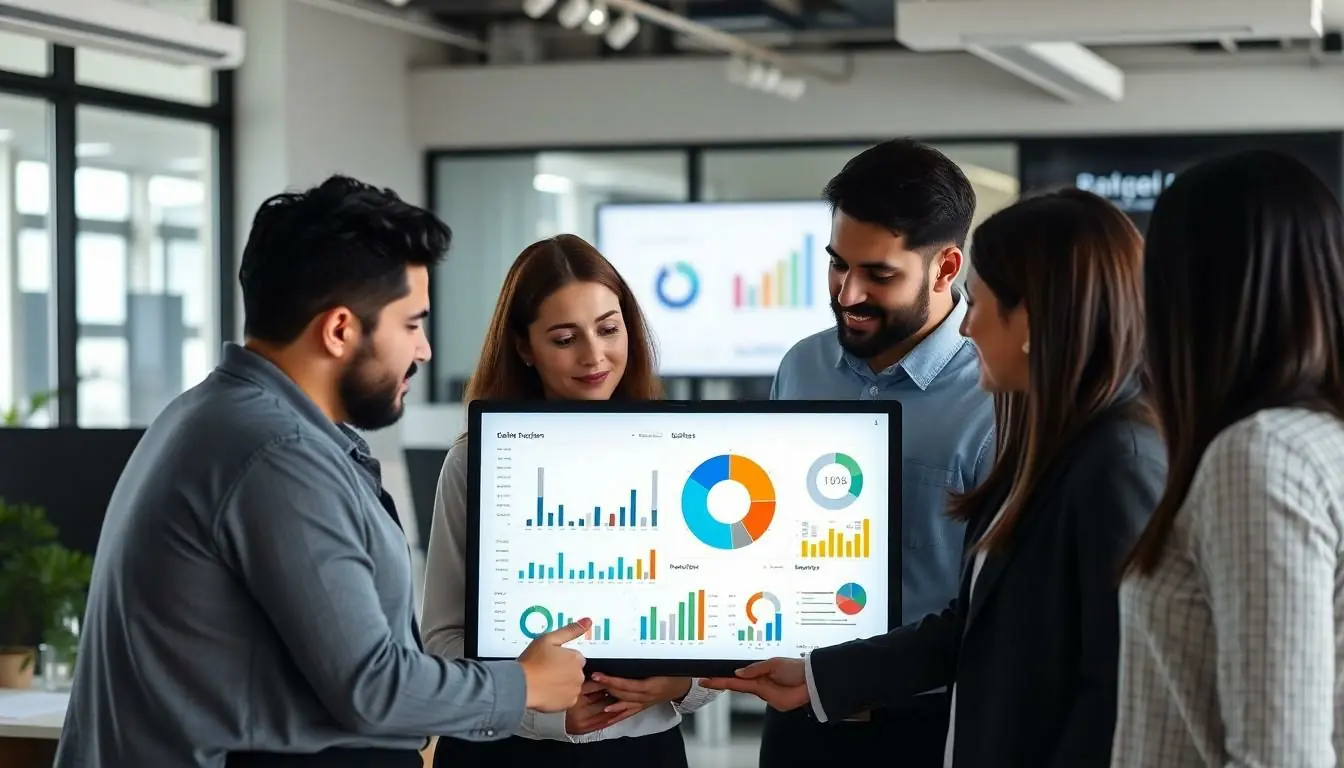In a world where data rules and visuals reign supreme, the quest for the perfect graph can feel like searching for a needle in a haystack. Enter ChatGPT, the AI that’s not just a wordsmith but also a potential graph wizard. Ever wondered if this clever chatbot can whip up a graph faster than you can say “data visualization”? Spoiler alert: it can’t draw a stick figure, but it can guide you through the process of creating stunning graphs with just a few clicks.
Table of Contents
ToggleOverview of ChatGPT
ChatGPT serves as an advanced AI language model, created by OpenAI. It relies on machine learning techniques, particularly deep learning, to process and generate human-like text. This functionality enables users to engage in meaningful conversations with the model, facilitating learning and understanding across various subjects.
The model has been trained on extensive datasets, covering diverse topics. Its knowledge spans a wide range of fields, including technology, science, and data visualization. Despite its capabilities, ChatGPT cannot generate graphs or images directly. Instead, it enhances the graph creation process by suggesting ideas, layouts, and techniques for effective data presentation.
During interactions, users can discuss their data requirements and visualize their thoughts with ChatGPT. The model can offer insights on best practices in data visualization and explain different types of graphs suitable for specific data sets. Suggestions may include bar charts for comparisons, line graphs for trends, and pie charts for proportional representations, among others.
Furthermore, ChatGPT aids in refining the narrative around graphs. It helps articulate the key messages and findings that graphs should convey. Users can receive guidance on essential elements like titles, labels, and legends, ensuring clarity and comprehension.
This AI-driven assistant significantly streamlines the visualization process. Its focus on dialogue allows users to clarify their objectives, enhancing overall effectiveness. ChatGPT may not create visuals itself, yet it provides invaluable support in crafting compelling data stories through insightful recommendations and clear explanations.
Capabilities of ChatGPT

ChatGPT offers unique capabilities that enhance the process of creating data visualizations. Although it doesn’t produce graphs directly, its advanced functionalities significantly contribute to efficient design.
Natural Language Processing
Natural language processing enables ChatGPT to understand user queries with precision. It interprets complex requests and generates responses based on context, enhancing the interaction experience. Specific phrases or terminologies related to data visualization trigger tailored suggestions. Engaging with the model allows users to describe their data needs, leading to relevant recommendations on visualization techniques. For example, when a user mentions “comparing sales data,” ChatGPT may suggest using bar charts for clarity. This capability streamlines communication, ensuring users clarify their objectives effectively.
Data Interpretation
Data interpretation stands as another critical strength of ChatGPT. The model analyzes user-provided data and creates visual narratives from it. When users share datasets, ChatGPT identifies trends and key insights, providing actionable recommendations. It distinguishes between various graph types and their most effective applications. By doing so, ChatGPT empowers users to make informed decisions about graph selection. For instance, it might recommend pie charts for displaying market share percentages. This thorough understanding helps users craft compelling visual presentations that clearly convey their messages.
Graph Generation Features
ChatGPT enhances the graph creation process, even though it cannot generate graphs directly. It assists users by providing guidance on effective data visualization methods and types of graphs suitable for various datasets.
Types of Graphs
Bar charts serve well for comparisons, allowing visual analysis of different categories. Line graphs represent trends over time, making them ideal for tracking changes. Pie charts illustrate proportions, offering intuitive insights into parts of a whole. Scatter plots reveal relationships between variables, perfect for identifying correlations. Users can engage with ChatGPT to determine the best graph types based on their specific data needs.
Limitations of Graph Generation
While ChatGPT excels in guiding users, it cannot create visual content such as graphs or images. Lack of direct generation limits its capabilities in producing visual outputs. Also, users must interpret and implement suggestions independently, requiring additional tools like graphing software. ChatGPT’s strengths lie in providing strategies and techniques, not in graphic rendering. Thus, users need to leverage additional resources to turn insights into fully developed visualizations.
Comparison with Other Tools
ChatGPT offers unique advantages for data visualization, though it lacks direct graph generation capabilities. Other tools provide distinct features that may complement or oppose its strengths.
Pros and Cons
Pros include its ability to suggest appropriate graph types and enhance user understanding of data visualization concepts. Users can easily interact with ChatGPT for tailored advice. Cons arise from its inability to create visual content, requiring users to utilize additional software for actual graph creation. Users often find the guidance helpful yet must acknowledge the need for extra tools to realize their visual ideas.
User Experience
User experience with ChatGPT revolves around seamless interaction and clarity. Many users appreciate the quick responses and detailed suggestions. Personalized insights cater to specific data needs, making the process straightforward. While users may enjoy the dialogue aspect, they often find the need to switch to graphing software to complete their projects. This dual approach enhances the overall experience, blending AI insights with practical graph creation tools.
ChatGPT proves to be an invaluable resource in the data visualization journey. While it can’t generate graphs directly, its ability to provide tailored suggestions and insights significantly enhances the graph creation process. By understanding user needs and recommending suitable visualization techniques, ChatGPT empowers users to make informed decisions.
The interaction with ChatGPT fosters a deeper understanding of data presentation, guiding users in crafting compelling narratives around their visuals. As users combine AI-driven insights with graphing tools, they can effectively translate their ideas into impactful visual representations. This synergy not only simplifies the visualization process but also enriches the overall experience of data storytelling.





